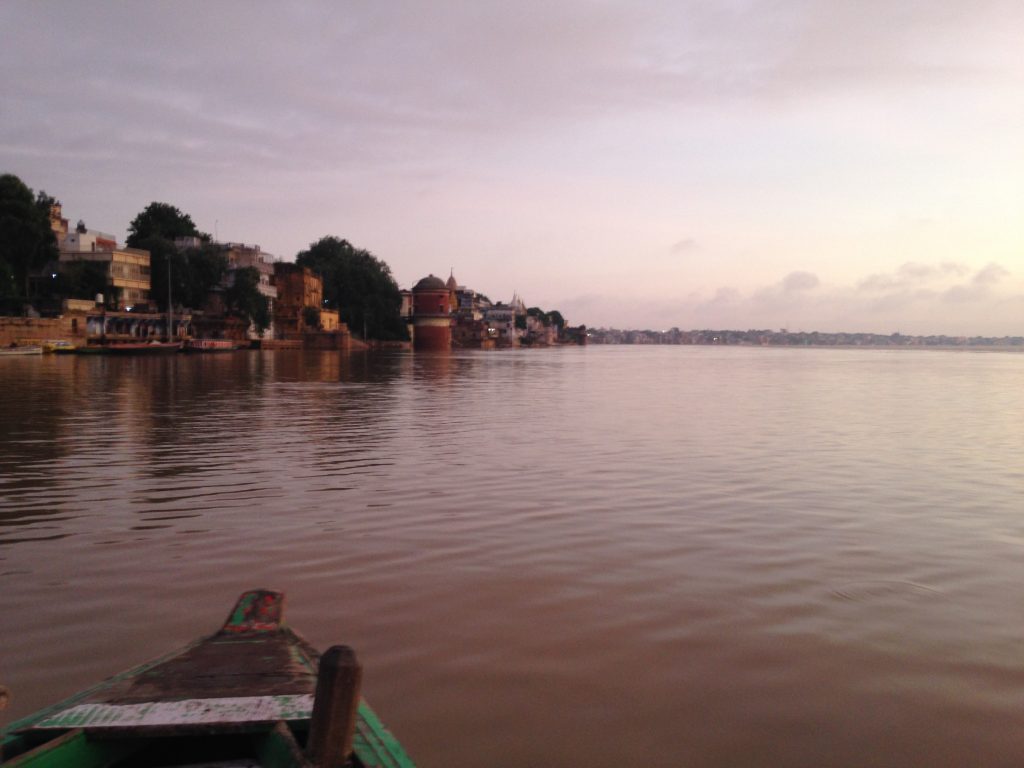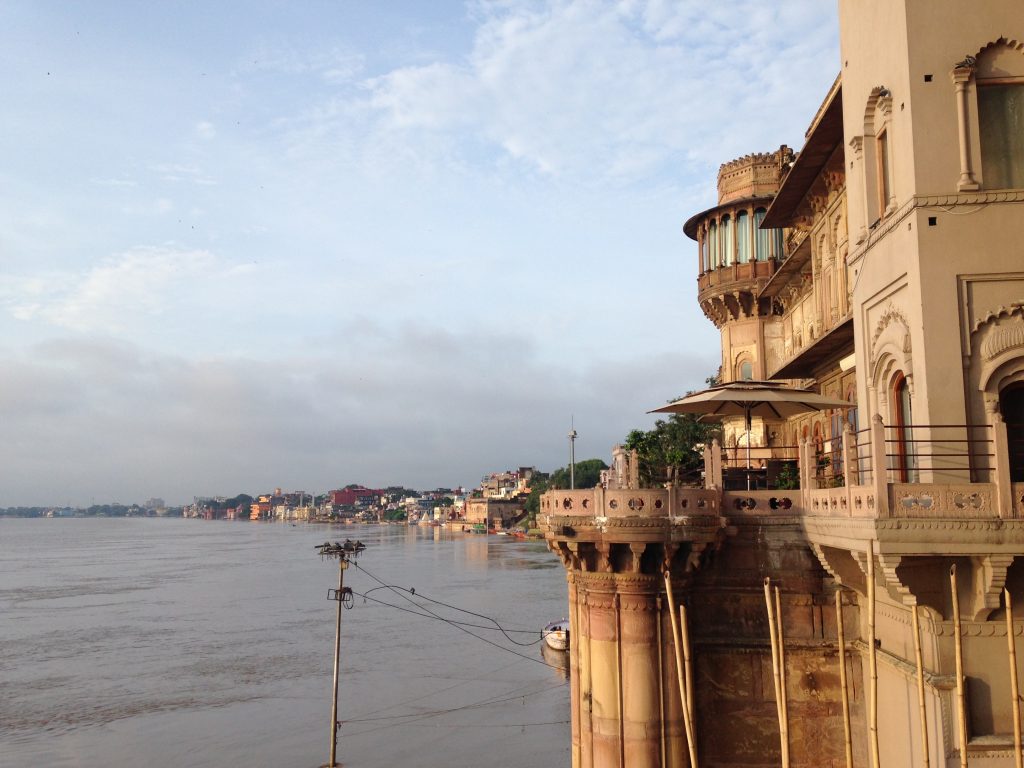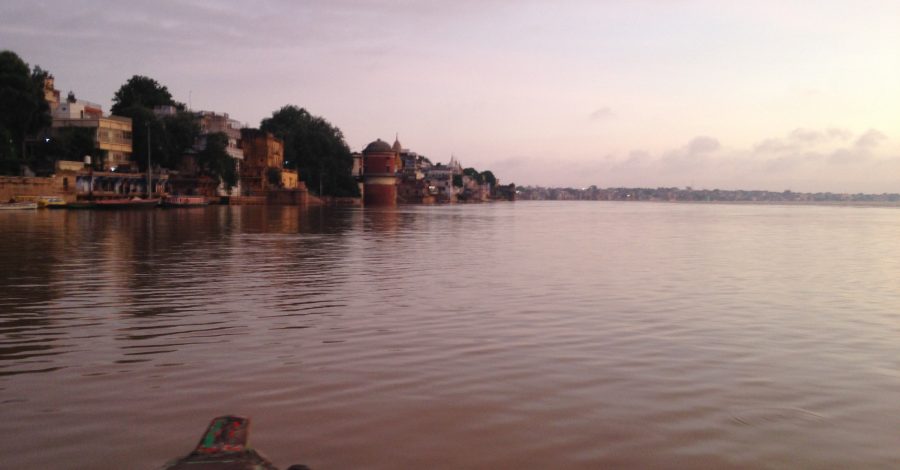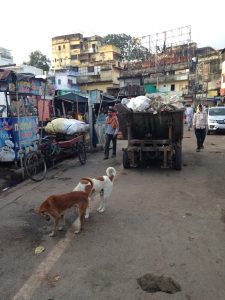
Varanasi is too much. It is too loud, too crowded, too narrow, too dirty, too dead. It is like an Indian nightmare of everyone fighting – pushing – their way through, of getting from A to B, of being more heard, more seen, faster, louder. It is a nightmare of running through narrow alleys, trying to not hit or get hit by cows, bicycles, scooters, cars,or other people pushing through. Avoiding to step into garbage, cow shit, dog shit, and who knows whatever else shit, avoiding to get peed on by a cow suddenly lifting its tail as if it was the only one around, of kids running in between your feet, dogs brushing past you, carts being wheeled under loud yells of the pusher shouting at people to get out of the way.
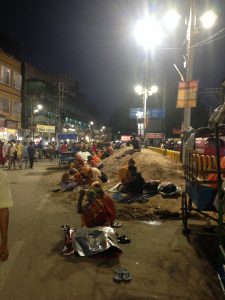
Varanasi is filthy. There is garbage everywhere. Early morning people bring out the collected trash from their houses to dump it in front of their houses. Women and men with dark skin and big brooms go around engaging in the all Indian morning sweeping, followed by carts drawn by young boys with even darker skin, collecting a rotting mixture of fruit peel, left over food, plastic, paper, full baby nappies, used sanitary napkins, along with the shit of various sort and shovel them into their collection vessel using nothing but two pieces of scrap carton and their bare hands. Nowhere in India have I seen anyone collecting garbage wearing even as much as gloves, proper shoes or any other protective gear, let alone use basic equipment like a shovel, a thong or a pan. Part of the thus collected garbage gets dumped right there in the center, on Assi road, one of the busiest throughfares of the city. There I saw a medium sized garbage truck (never moving but full of rotting trash), a small caterpillar in a Sisyphus like attempt to move the dripping sewage-like piles off the road, cows and dogs sniffing and eating and children in rags and barefoot stomping around in the sewage picking out plastic bottles and metal scrap.
Varanasi stinks. The ubiquitous garbage unites with the even more ubiquitous feces of all sorts, added by urine from the walls and streets where men relieve themselves. Frequently and in plain public sight. There is a slight scent of rotting water in the air, at times mixed with a hint of burning fire. Let’s assume the latter is rather from street food stalls than from burning corpses. Mixed in is the usual diesel aroma.
Varanasi is a burial place. Walking towards one ghat in the afternoon, I come across huge piles of log wood and big scales. Women and children in rags, dirty with uncombed hair, climb around, laughing, clearly enjoying the status of their key roles in the devout Hindu’s death ceremony. On the road there are small white trucks with open platforms lined up. I hear women wailing and catch a glimpse of the corpse in their middle. Surprised by what I just saw (had not expected to see the dead so in the middle of everything- not even in Varanasi), I suddenly find myself right at the waterfront. When I lift my eyes I look straight into the face of a dead person being immersed into the water. I stumble, but into the wrong direction, there are men everywhere, no clear path, dirt everywhere. The only way open, I climb up some stairs that lead to the cremation stands. Immediately men harshly push me away. One tries to drag me up an alley. “Here only family. Watch there,” he more shouts than says. It does not sound like an invitation, and I’m not in the slightest inclined to follow suit. The image of the dead face stays in my head.
That evening, tiptoeing down the alleys, eyes firmly on the ground to avoid stepping into whatever is there, suddenly a loud singsang can be heard, approaching rapidly. A group of men (dark skin, white clothes), run past, shouldering a stretcher with a bundle wrapped in orange colored fabric. It’s a corpse going heading for its last stop: the cremation pires at the ghats. Huge piles of logs serve better than any written sign could in announcing a dead end: this is it, the end of the road for the still alive as there is only (Ganga) water beyond and for the dead as this is where they are cremated. Large groups of men (and not more than 1 or 2 women) stand around, sit around, squat, wait, make noise. Stretchers with the dead are resting on the ground, amid all the dirt, waiting for their turn. Up some steps on a roofed platform the flames lodern. It is hot, lots of smoke. A surreal picture of Dante’s inferno. I try not to breath. I do not want to smell burning flesh. Dogs linger and sniff around for food. It’s a tense, disturbing, hostile atmosphere. Full of testosterone, oppression, meanness, disempowerment and disgust. A man with a whistle around his neck grabs my arm, shouts, “Come Madame, come see”, and drags me up the stairs while blowing his whistle leaving me almost deaf. I protest, almost screaming, pull myself free of the grip, all men stare at me of course – I’m used to that. I feel unwelcome, I don’t want to be there, how did I even get there, I do not want to see this, let me go. I fight my way back to the small alley that I came from and walk back up, almost running.


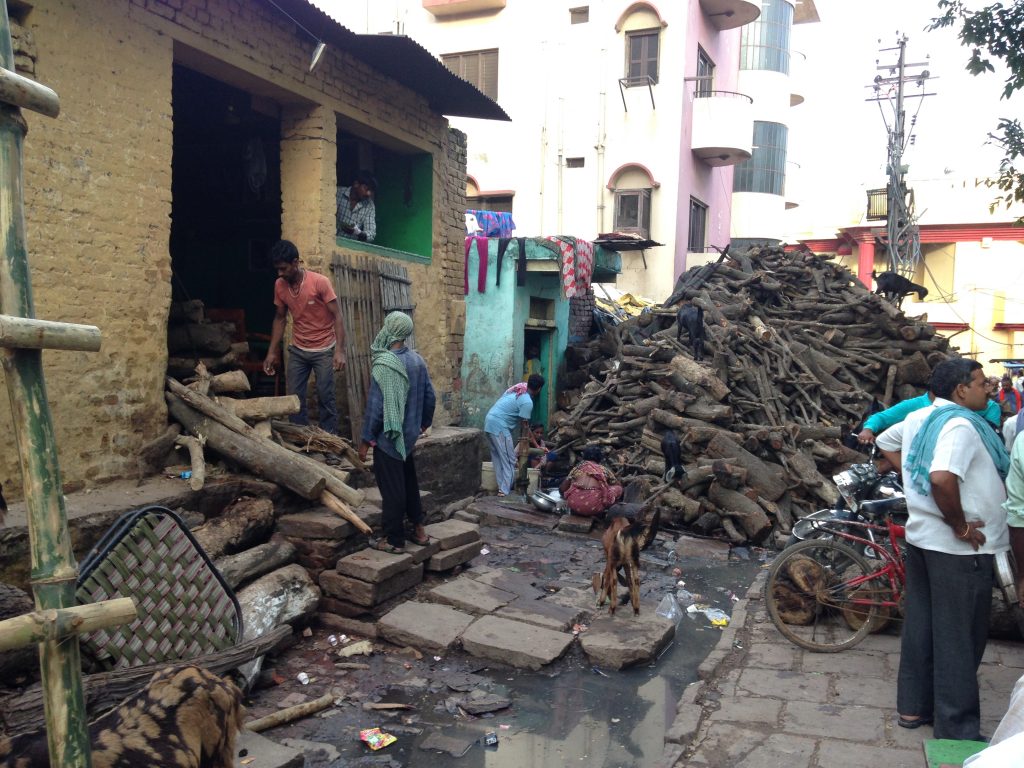
Varanasi is a holy place. Early morning the city seems somewhat at peace with itself. It’s early October, and with an exceptionally heavy monsoon still in full swing, no boats go out at sunrise. I will not see the city from the Ganga, not be able to do the single thing people come to Varanasi for other than to get cremated, wail and worship. So I aim at the one thing I really wanted to do while there: sit on ghat steps leading down into the water, watching people bath and the sun rise. As the city is still asleep and quiet, getting through the tiny alleys is easier. Only there are even more garbage and excrements everywhere. I have to tiptoe and keep my eyes firmly on the ground. Utterly disgusted, my stomach is turning. I’m terrified of slipping in some cow dung and landing in the sewage. Why is there so much left over cooked food dumped? It looks like half the ubiquitous cow population has got diarreah, and so do the dogs. Dog time is still ongoing (before humans take over again). There are more dogs around than cows, mostly in packs, and mostly not friendly. I manage to navigate my way through the maze to on ghat after another. Where are those famous stairs that feature in every Varanasi picture? Admiring a first row palace (hotel) I overhear a tourist guide saying that the water level is very high this year, and I realize that no matter how much I search, I will not find my steps into the water as they are now IN the water, fully covered.
